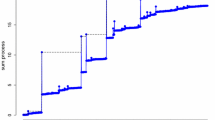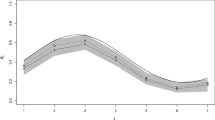Abstract
This paper aims to analyze the extremal properties of integer-valued moving average sequences obtained as discrete analogues of conventional moving averages replacing scalar multiplication by binomial thinning. In particular, we consider the case in which the scalar coefficients are replaced by random coefficients since in real applications the thinning probabilities may depend on several factors changing in time. Furthermore, the extremal behavior of periodic integer-valued moving average sequences is also considered. In this case, we find that, when assessing their clustering tendency of high-threshold exceedances, the extremal index is the same as for the stationary case.
Similar content being viewed by others
References
Anderson CW (1970) Extreme value theory for a class of discrete distributions with applications to some stochastic processes. J Appl Probab 7:99–113
Brännäs K, Hall A (2001) Estimation in integer-valued moving average models. Appl Stoch Models Bus Ind 17:277–291
Brännäs K, Hellström J (2006) Tourist accommodation effects of festivals. Tour Econ 12:291–302
Chernick M, Hsing T, McCormick W (1991) Calculating the extremal index for a class of stationary sequences. Adv Appl Probab 23:835–850
Embrechts P, Klüppelberg C, Mikosch T (1997) Modelling extremal events for insurance and finance. Springer, Berlin
Feller W (1971) An introduction to probability theory and its applications, vol II. Wiley, New York
de Haan L (1976) An Abel–Tauber theorem for Laplace transforms. J Lond Math Soc 13:537–542
Hall A (2001) Extremes of integer-valued moving averages models with regularly varying tails. Extremes 4:219–239
Hall A, Scotto MG (2006) Extremes of periodic integer-valued sequences with exponential type tails. REVSTAT 4:249–273
Hipel KW, McLeod AI (1994) Time series modelling of water resources and environmental systems. Elsevier, Amsterdam
MacDonald I, Zucchini W (1997) Hidden Markov and other models for discrete-valued time series. Chapman & Hall, London
Martins AP, Ferreira H (2004) Extremes of periodic moving averages of random variables with varying tail probabilities. Sort 28:161–176
McCormick WP, Park YS (1992) Asymptotic analysis of extremes from autoregressive negative binomial processes. J Appl Probab 29:904–920
Quoreshi AMMS (2006) Bivariate time series modelling of financial count data. Commun Stat Theory Methods 35:1343–1358
Resnick S (1987) Extreme values, regular variation, and point processes. Springer, New York
Tucker H (1967) A graduate course in probability. Academic Press, New York
WeißCH (2008) Thinning operations for modelling time series of counts—a survey. Adv Stat Anal 92:319–341
Author information
Authors and Affiliations
Corresponding author
Additional information
Research (partially) supported by Unidade de Investigação Matemática e Aplicações of Universidade de Aveiro through Programa Operacional “Ciência, Tecnologia, Inovação” of the Fundação para a Ciência e a Tecnologia (FCT) cofinanced by the European Community fund FEDER. The second author is also supported by the project PTDC/MAT/64353/2006.
Rights and permissions
About this article
Cite this article
Hall, A., Scotto, M. & Cruz, J. Extremes of integer-valued moving average sequences. TEST 19, 359–374 (2010). https://doi.org/10.1007/s11749-009-0158-6
Received:
Accepted:
Published:
Issue Date:
DOI: https://doi.org/10.1007/s11749-009-0158-6




